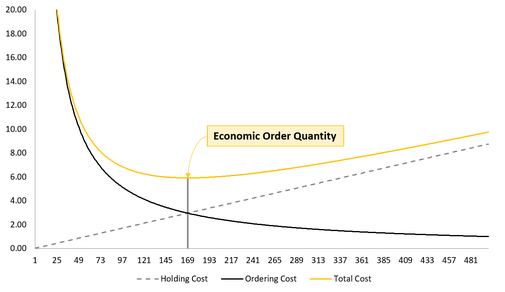PROCUREMENT
The objective of this article is not to present the operational procurement processes, which are the domain of ERP systems, but to explain the importance of the procurement management process from the perspective of SCM and integrated business planning: Such as - procedures for determining the economic order quantity and their integration into advanced SCM processes.
If you would like to know more about state-of-the-art software solutions for inventory optimization, please read "IBP for Inventory".
ECONOMIC ORDER QUANTITY (EOQ)
The crucial insight that led to EOQ was the fact that there is a trade-off between costs incurred in holding inventory and the fixed costs of ordering or manufacturing setup. The EOQ procedure attempts to balance these two (setup and inventory holding costs) by choosing an optimal order or production quantity.
For the cost to be optimal, several assumptions need to be true: demand must be constant and deterministic, there must be no interdependencies between products, and production must be instantaneous. Clearly, the assumptions are highly unrealistic, but the formulation does capture the essential trade-off and provides a first approximation. Furthermore, since the formula is not very sensitive to errors in the estimation of different costs, companies still use it for their ordering decisions, and ERP, APS software to this date include algorithms to calculate EOQ. In Figure 2, an example is visualized, where the trade-offs are shown. It can be seen that the order quantity of 169 units is when the total cost is the minimum, which also illustrates another property of the formula—where the total cost is the lowest, the holding costs equal the ordering costs.
From an implementation perspective in SAP, EOQ and certain variants of it are offered under the rubric of “Optimum Lot-Sizing Procedures” in S/4 HANA (there are four procedure that are available, namely, Part Period Balancing, Least Unit Cost Procedure, Groff Reorder Procedure, and Dynamic Lot Size Creation). These procedures require storage costs or holding costs and lot-size independent costs or ordering/setup costs to be maintained so that optimal lot sizes can be determined. In terms of integration with planning, a potential approach might be integrating the results with SAP IBP so that the lot sizes are considered a given by the planning algorithms. An implication, for instance, could be the inventory optimization algorithm taking the “economic” lot size as an input and calculating the safety stock accordingly as, intuitively, a bigger lot size provides greater coverage or lower exposure to stockouts and therefore calls for a smaller safety stock.

